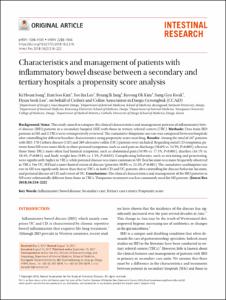KUMEL Repository
1. Journal Papers (연구논문)
1. School of Medicine (의과대학)
Dept. of Internal Medicine (내과학)
Characteristics and management of patients with inflammatory bowel disease between a secondary and tertiary hospitals: a propensity score analysis
- Keimyung Author(s)
- Lee, Yoo Jin
- Department
- Dept. of Internal Medicine (내과학)
- Journal Title
- Intestinal Research
- Issued Date
- 2018
- Volume
- 16
- Issue
- 2
- Abstract
- Background/Aims:
This study aimed to compare the clinical characteristics and management patterns of inflammatory bowel disease (IBD) patients in a secondary hospital (SH) with those in tertiary referral centers (TRC).
Methods:
Data from IBD patients in SH and 2 TRCs were retrospectively reviewed. The cumulative thiopurine use rate was compared between hospitals after controlling for different baseline characteristics using propensity score matching.
Results:
Among the total of 447 patients with IBD, 178 Crohn's disease (CD) and 269 ulcerative colitis (UC) patients were included. Regarding initial CD symptoms, patients from SH were more likely to show perianal symptoms, such as anal pain or discharge (56.6% vs. 34.3%, P=0.003), whereas those from TRCs more often had luminal symptoms, such as abdominal pain (54.9% vs. 17.1%, P<0.001), diarrhea (44.1% vs. 18.4%, P<0.001), and body weight loss (9.8% vs. 1.3%, P=0.025). Complicating behaviors, such as stricturing and penetrating, were significantly higher in TRCs, while perianal disease was more common in SH. Ileal location was more frequently observed in TRCs. For UC, SH had a more limited extent of disease (proctitis 58.8% vs. 21.2%, P<0.001). The cumulative azathioprine use rate in SH was significantly lower than that in TRCs in both CD and UC patients after controlling for disease behavior, location, and perianal disease of CD and extent of UC.
Conclusions:
The clinical characteristics and management of the IBD patients in SH were substantially different from those in TRCs. Thiopurine treatment was less commonly used for SH patients.
- Keimyung Author(s)(Kor)
- 이유진
- Publisher
- School of Medicine (의과대학)
- Citation
- Ki Hwan Song et al. (2018). Characteristics and management of patients with inflammatory bowel disease between a secondary and tertiary hospitals: a propensity score analysis. Intestinal Research, 16(2), 216–222. doi: 10.5217/ir.2018.16.2.216
- Type
- Article
- ISSN
- 1598-9100
- Appears in Collections:
- 1. School of Medicine (의과대학) > Dept. of Internal Medicine (내과학)
- 파일 목록
-
-
Download
 oak-2018-0206.pdf
기타 데이터 / 545.2 kB / Adobe PDF
oak-2018-0206.pdf
기타 데이터 / 545.2 kB / Adobe PDF
-
Items in Repository are protected by copyright, with all rights reserved, unless otherwise indicated.